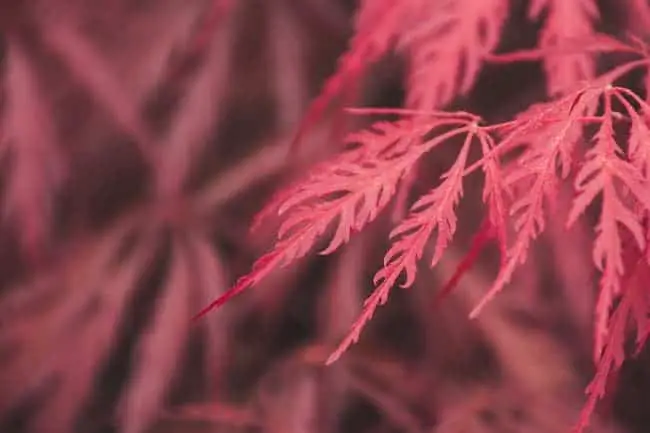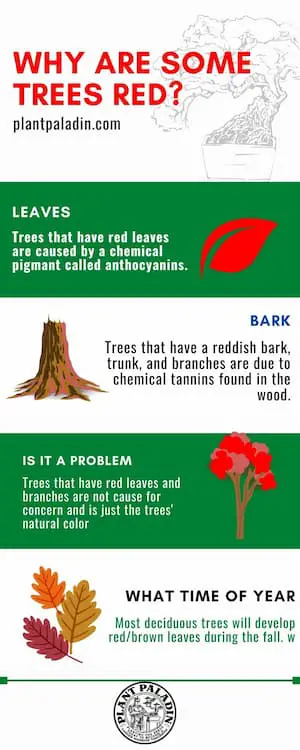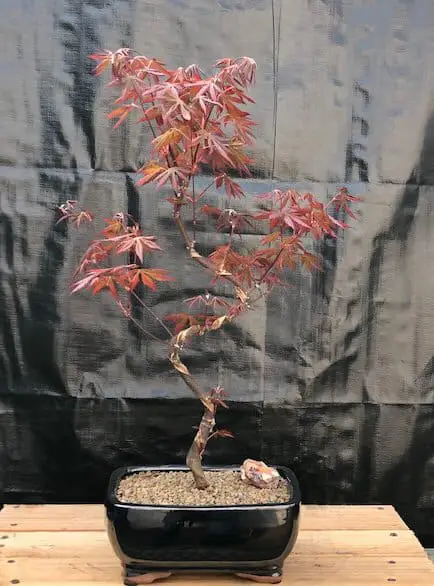This website is supported by its readers. If you click one of my links I may earn a commission. I am also a participant in the Amazon affiliates program and I will also earn a commission from qualified purchases.

So I recently added a Japanese maple bonsai tree to my collection, mainly to pair it up with the giant full-sized maple tree and the bottom of my garden. One question I’ve always had is why some trees are red. And why are some trees’ leaves red?
Red trees and red tree leaves are primarily caused by a red pigment called anthocyanins. This pigment then impacts the tree’s bark, branch, and leaf color. As such, trees with many anthocyanins will naturally be redder in color.
So what tree species are naturally red? And are red tree leaves a cause for concern? Keep reading to find out more!
Why are some trees red?
To understand why trees are red, I contacted my local botanical gardens, reached out to my local gardener, and even surveyed 20 plant paladin readers, asking them why some trees are red.
To summarize:
- The leading cause of a red tree is a red pigment called anthocyanins.
- This pigment impacts the color of a tree’s leaves, branches, bark, and roots.
- Trees that contain a lot of anthocyanins will naturally display a stronger reddish color than trees with little anthocyanins. The most common part of a tree that will be red is the leaves, with many common trees displaying bright red leaves throughout the year.
- Some of the most common tree species that display red leaves include Japanese Maple trees, Smokebush, Katsura, and Red Robins.
- Some trees also contain reddish bark, including the Japanese paperback, river birch, and Japanese Stewartia.
- Most trees will experience red leaves at some point in their lives, with most deciduous trees having their leaves turn either bright yellow or dark red during the fall.
- While red leaves are not a cause for concern, if your tree has naturally green leaves that are randomly starting to turn red, this could be due to mild potassium, magnesium, or nitrogen deficiency.
Now this is a lot of information to take in, so let’s dive into more detail:

Why do some trees have red leaves – the exact science
So, the vast majority of you are reading this because you are either:
- Concerned that your tree is randomly developing red leaves
- Interested in buying a tree with red leaves.
That said, I wanted to go into more detail on the exact science that causes red leaves.
Well, it all comes down to one word; anthocyanins.
According to Harvard Forest, Anthocyanins are water-soluble pigments produced via the flavonoid pathway in the cytoplasm of the colored plant cell.
“The attachment of the sugar molecule makes them particularly soluble in the sap of the vacuole, where these molecules are stored…..once they are launched. These are responsible for the pink-red colors of most flower petals, most red fruits (like apples), and almost all red leaves during the autumn. Anthocyanins absorb light in the blue-green wavelengths, allowing the red wavelengths to be scattered by the plant tissues to make these organs appear red.”
Typically then leaves that contain higher amounts of anthocyanins. Due to genetic differences are much more likely to turn red.
On top of this, trees with red leaves and yellow leaves have a lot of anthocyanins, but exposure to the sun will determine the exact color.
For example, if the leaf is shady, these leaves turn yellow compared to leaves that grow in the full sun, which turn red.
What trees have red leaves?
So now we know why trees have red leaves; what are some examples of common tree species with red leaves?
Japanese Maple and other Acer varieties, Smokebush, Red Oak, and Red Robin trees all contain bright red flowers. Other varieties, such as Red Oak, have green leaves during the spring and summer and bright red leaves in the fall.
SPECIES
LEAF COLOR
Red Oak
Green to red in fall
Japanese Maple
Red to pink
Japanese Rowan
Bright red
Smokebush
Dark Red/Purple
Red Robin
Light red/dark orange
Katsura
Green in the summer light red in the fall
Crimson Cascade
Dark red/Light Purple
Let’s go into more detail on caring for these trees.
Red Oak (Quercus rubra):
Season of Red Leaves: The red leaves of Red Oak typically develop in the fall. They undergo a breathtaking transformation, turning fiery shades of red and orange before dropping.
Sunlight Requirements: Red Oaks thrive in full sun to partial shade, making them adaptable to various light conditions.
Water Requirements: These trees have moderate water needs, especially during dry or hot seasons. Ensure the soil stays evenly moist but not soggy.
Ideal Temperature: Red Oaks are hardy trees and can tolerate various temperatures. They prefer cool to mild climates but can handle heat and cold moderately well.
Risks and Pests: Red Oaks can be susceptible to pests like oak wilt and borers. Regular inspections and prompt treatment can help mitigate these risks.
Japanese Maple (Acer palmatum):

Season of Red Leaves: Japanese Maples showcase their red leaves in the fall. The foliage takes on various shades of red, from crimson to burgundy, creating a breathtaking autumn display.
Sunlight Requirements: Japanese Maples prefer partial shade to protect their delicate leaves from scorching. Some varieties can tolerate full sun if well-hydrated.
Water Requirements: Adequate watering is crucial, especially during the growing season. Keep the soil consistently moist but not soggy.
Ideal Temperature: Japanese Maples thrive in mild to cool climates. They are not suitable for areas with extreme heat.
Risks and Pests: These trees are susceptible to aphids, scale insects, and fungal diseases. Regular pruning and proper care can help prevent infestations.
Japanese Rowan (Sorbus commixta):
Season of Red Leaves: The red leaves of Japanese Rowan appear in the fall, creating a stunning contrast against its berries.
Sunlight Requirements: Japanese Rowans prefer full sun but can tolerate light shade.
Water Requirements: These trees have moderate water needs. Water them regularly, especially during prolonged dry periods.
Ideal Temperature: Japanese Rowans prefer cooler climates and can be sensitive to extreme heat.
Risks and Pests: Japanese Rowans are pest-resistant, but watch out for aphids and caterpillars.
Smokebush (Cotinus coggygria):
Season of Red Leaves: Smokebushes showcase their red leaves in the fall, adding drama to the autumn landscape.
Sunlight Requirements: Smokebushes love total sun exposure to showcase their stunning red foliage.
Water Requirements: While they are drought-tolerant once established, consistent watering during the initial stages is essential.
Ideal Temperature: Smokebushes are adaptable to various temperatures but thrive in warm climates.
Risks and Pests: Smokebushes are generally low-maintenance but can attract aphids and caterpillars occasionally.
Red Robin (Photinia x fraseri):
Season of Red Leaves: Red Robins display their red leaves year-round, making them a captivating sight in any season.
Sunlight Requirements: Red Robins prefer full sun to partial shade.
Water Requirements: Water regularly, especially during hot weather or dry spells.
Ideal Temperature: Red Robins do well in mild to warm climates.
Risks and Pests: These trees are susceptible to fungal diseases like leaf spots. Adequate spacing and good air circulation can help prevent issues.
Katsura (Cercidiphyllum japonicum):
Season of Red Leaves: The red leaves of Katsura appear in the fall, creating a breathtaking display of warm hues.
Sunlight Requirements: Katsura trees prefer partial shade to protect their delicate leaves from sunburn.
Water Requirements: They have moderate water needs, and the soil should be kept evenly moist.
Ideal Temperature: Katsura trees thrive in temperate climates and prefer cool, humid conditions.
Risks and Pests: Katsura trees are generally pest-resistant but may occasionally face issues with leaf miners and canker diseases.
Crimson Cascade (Cercis canadensis’ Crimson Cascade’):
Season of Red Leaves: Crimson Cascade Redbuds showcase their red leaves in the spring, and the foliage retains its red hue throughout the summer before turning yellow in the fall.
Sunlight Requirements: Crimson Cascade Redbuds thrive in full sun to partial shade.
Water Requirements: Adequate watering is crucial, especially during the first year after planting.
Ideal Temperature: These trees prefer mild to warm climates but can tolerate some cold.
Risks and Pests: Crimson Cascade Redbuds are relatively low-maintenance but susceptible to verticillium wilt and canker diseases.
What trees have red trunks?
So now we know which trees have red leaves; what trees also have red trunks and branches?
After all, most trees have dark brown bark, so do any trees have light/ brown/ reddish trunks?
Japanese Stewartia, Tibetan cherry, red pine, and Lacebark Elm all have reddish-colored bark. This is due to the increased number of tannins in the tree bark, which causes reddish brown tree bark.
To help explain in more detail, I’ve listed a few trees in the table below that have a reddish tinge to their bark, branches, and trunk:
Tree Name
Scientific Name
Bark Color
Japanese Stewartia
Stewartia pseudocamellia
Reddish-brown
Tibetan Cherry
Prunus serrula
Mahogany-red
Japanese Red Pine
Pinus densiflora
Reddish-brown
Lacebark Elm
Ulmus parvifolia
Mottled reddish-brown
Paperbark Maple
Acer griseum
Cinnamon-red
Crape Myrtle
Lagerstroemia indica
Mottled cinnamon
River Birch
Betula nigra
Salmon-pink
Arbutus
Arbutus unedo
Reddish-brown
Red Maple
Acer rubrum
Reddish-brown
Red-twig Dogwood
Cornus sericea
Bright red
Japanese Bloodgood Maple
Acer palmatum 'Bloodgood'
Dark red
American Sycamore
Platanus occidentalis
Patchy brown-red
Red Birch
Betula nigra var. rubra
Reddish-brown
Coral Bark Japanese Maple
Acer palmatum 'Sango-kaku'
Coral-red
Red Beech
Fagus sylvatica 'Atropunicea'
Purplish-red
Red-tailed Guava
Psidium guajava 'Red-tailed'
Reddish-brown
Red Horse Chestnut
Aesculus x carnea
Reddish-brown
Red Osier Dogwood
Cornus sericea
Bright red
Eastern Redbud
Cercis canadensis
Dark reddish-brown
Red Maple
Acer rubrum
Reddish-brown
Why do trees have red bark?
So while most trees have brown bark, what causes an increased reddish tinge?
Well, it all has to do with tannins.
You see, while the red in leaves is caused by the red pigment anthocyanins in the bark branches and trunk, this is all due to tannins.
Tannins are chemical compounds found naturally in almost all trees to varying degrees. These tannins are most commonly found in the tree bark, branches trunk, inner wood, and roots and leaves.
Tannins help your tree protect itself from excessive sunlight, fungus, and insect infestation.
As such, trees with a reddish tint to their bak are usually grown in hot, humid conditions and need more wood tannins to protect the tree.
What trees are completely red?
Japanese Stewartia, Tibetan Cherry, Japanese Maple, and Japanese red pine are all trees with red leaves and reddish bark. Japanese red pine trees have red leaves and red bark year-round.
Tree Name
Scientific Name
Red Leaves Season
Bark Color
Japanese Stewartia
Stewartia pseudocamellia
Fall
Reddish-brown
Tibetan Cherry
Prunus serrula
Spring
Mahogany-red
Japanese Red Pine
Pinus densiflora
Year-round
Reddish-brown
Lacebark Elm
Ulmus parvifolia
Fall
Mottled reddish-brown
Paperbark Maple
Acer griseum
Fall
Cinnamon-red
Coral Bark Japanese Maple
Acer palmatum 'Sango-kaku'
Spring, Fall
Coral-red
Eastern Redbud
Cercis canadensis
Spring
Dark reddish-brown
Red-twig Dogwood
Cornus sericea
Fall, Winter
Bright red
Red Maple
Acer rubrum
Fall
Reddish-brown
American Sycamore
Platanus occidentalis
Fall
Patchy brown-red
What time of year does a tree’s leaves turn red?
Most deciduous trees will have their leaves turn red in the middle of fall, typically the first two weeks of October. This is because as trees prepare for winter, they remove the stored energy from the leaves to the inner wood of the tree, causing the leaves to turn red.
What trees have red leaves year-round?
While most trees usually create red leaves in the fall, Japanese Red Pine trees have red leaves and reddish-brown bark year-round. If you are interested in a pop of color in your tree collection, consider investing in one of these species.
Why do some trees have red leaves and some trees have yellow?
The exact color of a tree’s leaf depends on the specific pigment a tree contains. Trees that have red leaves have higher concentrations of anthocyanin pigment. Trees that have yellow leaves have higher concentrations of xanthophyll.
Another key reason for differences in leaf color is how much exposure to direct sunlight the tree has.
Trees with red leaves are usually more exposed to direct sunlight than trees with yellow or orange leaves.
Why do some trees turn red before others?
Various factors, including species-specific traits, environmental conditions, and physiological responses to changing seasons, can influence the timing of trees turning red.
Here are some reasons why some trees may turn red before others:
Species Differences
Different tree species have distinct growth and development patterns. Some species are programmed to change color earlier in the fall, while others may hold onto their green leaves for longer. The genetic makeup of each species determines the timing of their color change.
Temperature and Daylight
The changing color of leaves is triggered by the decreasing amount of daylight and cooler temperatures in the fall. As days shorten and temperatures drop, trees receive signals to prepare for winter. Trees in colder regions may turn red earlier, while those in milder climates might change color later.
Chlorophyll Breakdown
The vibrant green color of leaves during spring and summer is primarily due to chlorophyll, the pigment responsible for photosynthesis. As the days become shorter, chlorophyll production decreases, and it starts breaking down. This process reveals other pigments, like anthocyanins, responsible for red, purple, and blue colors, causing the leaves to turn red.
Moisture and Soil Conditions
Trees experiencing water stress or growing in dry soil may lose their leaves earlier than those in well-hydrated areas. Moisture availability plays a role in determining when leaves change color and drop.
Altitude and Latitude
Trees at higher elevations or latitudes typically experience colder temperatures sooner, leading to earlier fall foliage changes.
Adaptive Strategies
Some trees may have evolved to change color early as an adaptive strategy to optimize their use of resources before winter. By shedding their leaves earlier, these trees can conserve energy and water during the colder months.
Internal Clocks
Trees have internal biological clocks that help regulate their growth and development. These clocks are influenced by environmental cues like temperature and day length, affecting the timing of leaf color changes.
Photoperiod Sensitivity
Trees can be sensitive to changes in the length of daylight. As the nights get longer in the fall, this photoperiod sensitivity triggers the onset of color change.
Are red trees a cause for concern?
Trees with red leaves are not a cause for concern, with most displaying red leaves due to individual pigmentation.
That said, four problems have historically caused red leaves that are not natural, which include:
Drought Stress
In some cases, trees may turn red due to drought stress. Insufficient water supply can lead to a premature change of leaf color, indicating that the tree is struggling and needs proper irrigation.
Nutrient Deficiencies
Red or discolored leaves can also be a sign of nutrient deficiencies, particularly if the red coloration is accompanied by other symptoms like yellowing or wilting leaves.
Nutrient deficiencies can impact the tree’s health and growth.
Pest or Disease Infestations
Certain pests or diseases can cause red spots, discoloration, or other abnormalities in tree leaves or bark. These signs may indicate an infestation that requires prompt action to prevent further damage.
Environmental Pollution:
Trees can be stressed in urban areas with high pollution levels, leading to altered leaf color. Red or discolored leaves may indicate environmental pollution affecting the tree’s health.
Survey results on why some trees are red
Finally, I surveyed 20 plant paladin readers. Asking them why some trees are red. To summarise:
